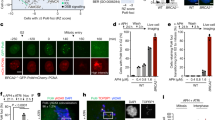Abstract
Polo-like kinases (PLKs) have an important role in several stages of mitosis. They contribute to the activation of cyclin B/Cdc2 and are involved in centrosome maturation and bipolar spindle formation at the onset of mitosis1,2. PLKs also control mitotic exit by regulating the anaphase-promoting complex (APC) and have been implicated in the temporal and spatial coordination of cytokinesis1,2. Experiments in budding yeast have shown that the PLK Cdc5 may be controlled by the DNA damage checkpoint3,4. Here we report the effects of DNA damage on Polo-like kinase-1 (Plk1) in a variety of human cell lines. We show that Plk1 is inhibited by DNA damage in G2 and in mitosis. In line with this, we show that DNA damage blocks mitotic exit. DNA damage does not inhibit the kinase activity of Plk1 mutants in which the conserved threonine residue in the T-loop has been changed to aspartic acid, suggesting that DNA damage interferes with the activation of Plk1. Significantly, expression of these mutants can override the G2 arrest induced by DNA damage. On the basis of these data we propose that Plk1 is an important target of the DNA damage checkpoint, enabling cell-cycle arrests at multiple points in G2 and mitosis.
This is a preview of subscription content, access via your institution
Access options
Subscribe to this journal
Receive 12 print issues and online access
$209.00 per year
only $17.42 per issue
Buy this article
- Purchase on Springer Link
- Instant access to full article PDF
Prices may be subject to local taxes which are calculated during checkout



Similar content being viewed by others
References
Glover, D. M., Hagan, I. M. & Tavares, A. A. Genes Dev. 12, 3777–3787 (1998).
Nigg, E. A. Curr. Opin. Cell. Biol. 10, 776–783 (1998).
Cheng, L., Hunke, L. & Hardy, C. Mol. Cell. Biol. 18, 7360–7370 (1998).
Sanchez, Y. et al. Science 286, 1166–1171 (1999).
Hartwell, L. M. & Kastan, M. B. Science 266, 1821–1828 (1994).
Pines, J. Nature 397, 104–105 (1999).
Furnari, B., Blasina, A., Boddy, M., McGowan, C. & Russell, P. Mol. Biol. Cell. 10, 833–845 (1999).
Hoffmann, I., Clarke, P. R., Marcote, M. J., Karsenti, E. & Draetta, G. EMBO J. 12, 53–63 (1993).
Izumi, T. & Maller, J. L. Mol. Biol. Cell 4, 1337–1350 (1993).
Kumagai, A. & Dunphy, W. G. Science 273, 1377–1380 (1996).
Qian, Y. W., Erikson, E., Li, C. & Maller, J. L. Mol. Cell. Biol. 18, 4262–4271 (1998).
Golsteyn, R. M., Mundt, K. E., Fry, A. M. & Nigg, E. A. J. Cell Biol. 129, 1617–1628 (1995).
Abrieu, A. et al. J. Cell Sci. 111, 1751–1757 (1998).
Kotani, S. et al. Mol. Cell 1, 371–380 (1998).
Karaiskou, A., Jessus, C., Brassac, T. & Ozon, R. J. Cell Sci. 112, 3747–3756 (1999).
Blasina, A., Price, B., Turenne, G. & McGowan, C. Curr. Biol. 9, 1135–1138 (1999).
Shirayama, M., Zachariae, W., Ciosk, R. & Nasmyth, K. EMBO J. 17, 1336–1349 (1998).
Descombes, P. & Nigg, E. A. EMBO J. 17, 1328–1335 (1998).
Tinker-Kulberg, R. L. & Morgan, D. O. Genes Dev. 13, 1936–1949 (1999).
Davis, F. M., Tsao, T. Y., Fowler, S. K. & Rao, P. N. Proc. Natl Acad. Sci. USA 80, 2926–2930 (1983).
Qian, Y., Erikson, E. & Maller, J. L. Science 282, 1701–1704 (1998).
Qian, Y., Erikson, E. & Maller, J. L. Mol.Cell.Biol. 19, 8625–8632 (1999).
Lee, K. & Erikson, R. Mol. Cell. Biol. 17, 3408–3417 (1997).
Peng, C. Y. et al. Science 277, 1501–1505 (1997).
Sibon, O. C. M., Kelkar, A., Lemstra, W. & Theurkauf, W. E. Nature Cell Biol. 2, 90–95 (2000).
Lane, H. & Nigg, E. J. Cell Biol. 135, 1701–1713 (1996).
Kalejta, R. F., Shenk, T. & Beavis, A. J. Cytometry 29, 286–291 (1997).
Smits, V. A. J. et al. J. Biol. Chem. 275, 19375–19381 (2000).
Charles, J. F. et al. Curr. Biol. 8, 497–507 (1998).
Acknowledgements
We thank H. Piwnica-Worms for providing the Cdc25C plasmids and GST–Cdc25C, O. Kelm and P. Duncan for reagents and comments on the manuscript, S. Pippel for technical assistance and the members of the Jordan laboratory and the Department of Physiological Chemistry for helpful discussions. This work was supported by a grant from the Dutch Cancer Society (UU 96-1176).
Author information
Authors and Affiliations
Corresponding author
Rights and permissions
About this article
Cite this article
Smits, V., Klompmaker, R., Arnaud, L. et al. Polo-like kinase-1 is a target of the DNA damage checkpoint. Nat Cell Biol 2, 672–676 (2000). https://doi.org/10.1038/35023629
Received:
Revised:
Accepted:
Published:
Issue Date:
DOI: https://doi.org/10.1038/35023629
This article is cited by
-
Hornerin mediates phosphorylation of the polo-box domain in Plk1 by Chk1 to induce death in mitosis
Cell Death & Differentiation (2023)
-
Phospho PTEN mediated dephosphorylation of mitotic kinase PLK1 and Aurora Kinase A prevents aneuploidy and preserves genomic stability
Medical Oncology (2023)
-
SCFSKP2 regulates APC/CCDH1-mediated degradation of CTIP to adjust DNA-end resection in G2-phase
Cell Death & Disease (2020)
-
Squamous differentiation requires G2/mitosis slippage to avoid apoptosis
Cell Death & Differentiation (2020)
-
P53 suppresses SENP3 phosphorylation to mediate G2 checkpoint
Cell Discovery (2020)



